Braving the odds, front-line health workers are home delivering dry ration to millions of anganwadi kids and beneficiary mothers
Anganwadi workers and helpers are walking an extra mile to home deliver wheat, rice, pulses, oil, in some states even eggs and milk powder, to the beneficiaries of the government's supplementary nutrition programme

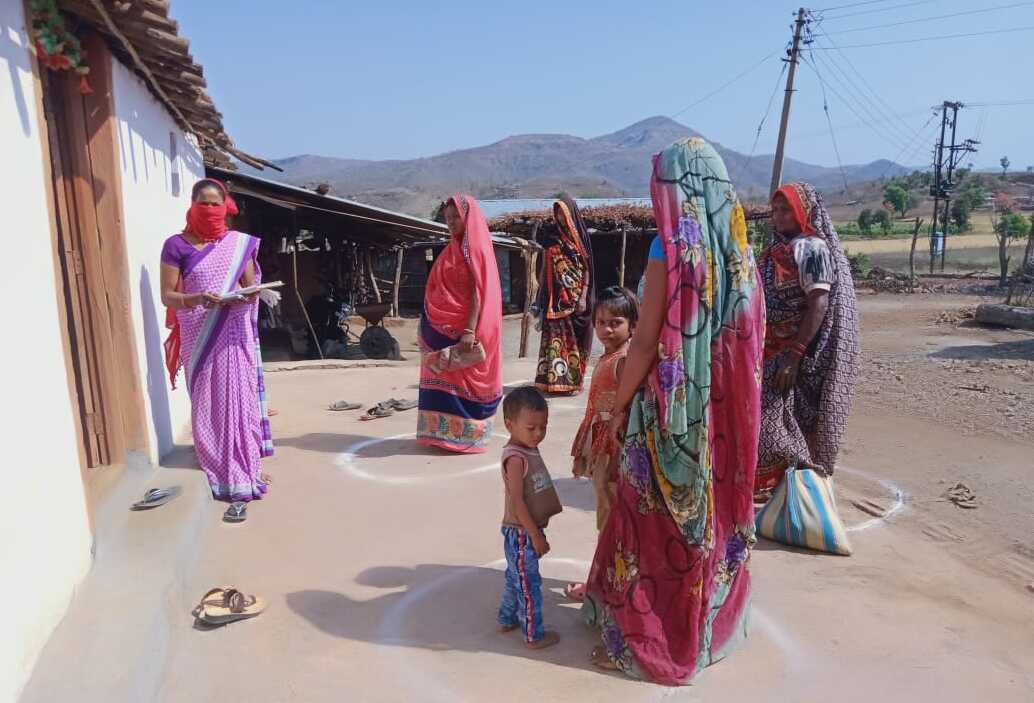
Every morning before leaving home, 31-year-old Sonali Hiwale covers her face with a mask, checks her bag for the mini-bottle of hand-wash and steps out to survey the village. Hiwale is anganwadi sevika of Sundarkhed village in Buldhana district of Maharashtra, about 500 kilometres from the state capital Mumbai. She is part of the frontline health staff helping fight coronavirus pandemic in the country.
Among other things, during the nationwide lockdown, Hiwale has to ensure all the children, and pregnant and lactating mothers registered with her anganwadi receive their due share of ration under the supplementary nutrition programme of the Integrated Child Development Services (ICDS) scheme of the government.
“I have already distributed dry ration to 22 kids in the age group of three to six years, 25 kids in under-three years category, and four pregnant and four lactating mothers registered with my anganwadi,” Hiwale told Gaon Connection. “Both kids and beneficiary women have been provided with ration, including wheat, pulses, oil and spices, for the months of March and April,” she added.
The ICDS is the world’s largest programme for early childhood care and development covering over 158 million children (2011 Census) in the 0-6 years age group, and pregnant and lactating mothers in the country. This unique programme offers six services: supplementary nutrition, preschool non-formal education, nutrition and health education, immunisation, health check-up and referral services, through 1.36 million functional anganwadi centres across the country (as of June 2018).
These anganwadis centres are looked after by frontline health staff: one anganwadi worker and one anganwadi helper each, both typically women like Hiwale.
At present, these women are not only helping deliver ration to the beneficiaries (anganwadis are closed across the country due to coronavirus outbreak), they are also educating the rural people about dos and don’ts on coronavirus, and preparing list of outsiders visiting the villages.
“Even though the anganwadis are closed, we are working daily and visiting the village informing people about physical distancing, washing hands and maintaining personal hygiene,” said Hiwale. “I have also prepared a list of outsiders who have visited the village and handed it over to our gram panchayat,” she added.
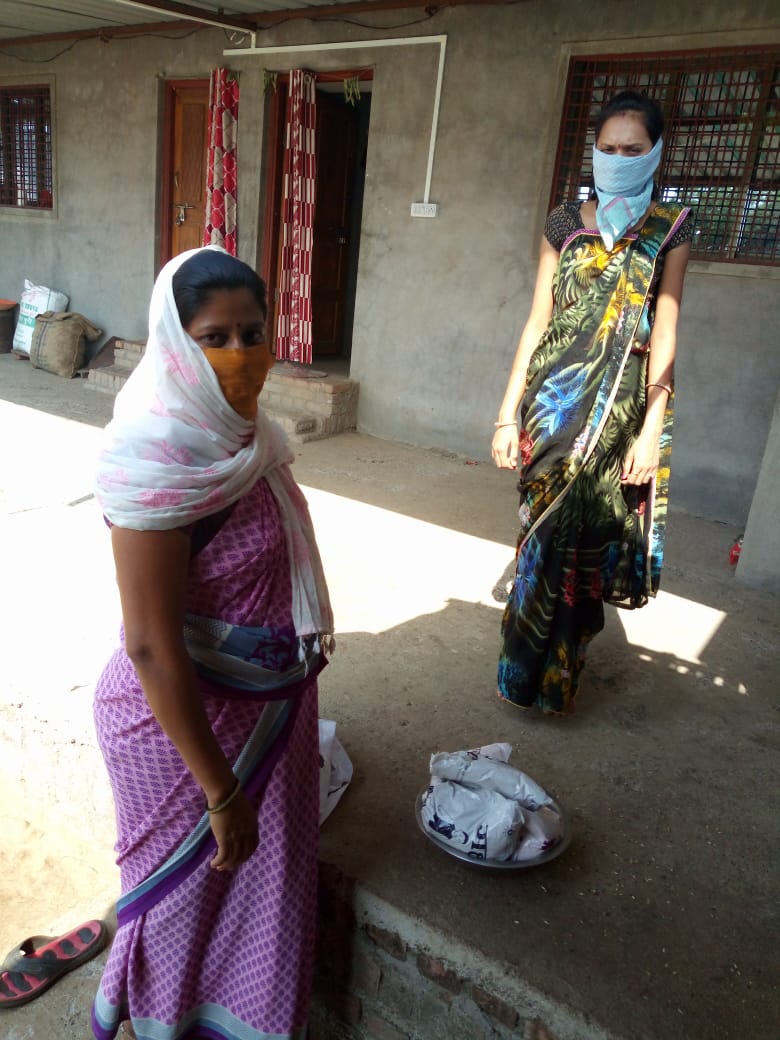
More than 1,000 kilometres away, Nagarathna Malur, another anganwadi worker in Kolar district of Karnataka, covers her mouth and nose with a thick, long scarf and daily walks kilometres carrying large bags of take-home ration for kids, and pregnant and lactating mothers registered with her anganwadi. She is accompanied by an anganwadi helper.
Unlike Maharashtra, where rice, wheat, pulses and spices are being provided, Karnataka also provides eggs and milk to the beneficiaries registered with anganwadis. The southern state has a total of 65,911 anganwadi centres catering to the needs of 3.86 million children between the ages of six months to six years.
“I am home delivering dry ration that includes rice, pulses, jaggery, spices, eggs and milk powder,” Malur told Gaon Connection. “In Karnataka, anganwadi children in the age group of three years to six years receive two eggs and five times milk a week. Also, pregnant and lactating mothers are provided six eggs and six times milk a week. We are home delivering eggs and milk powder, too,” she added.
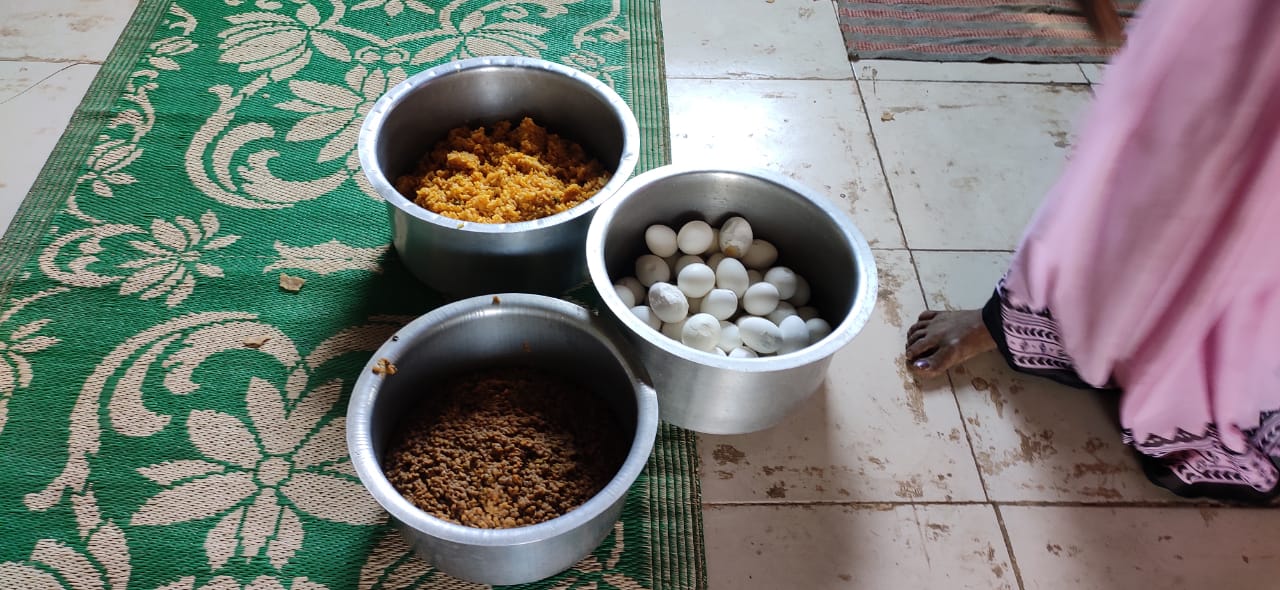
Malur doesn’t have a vehicle of her own, so she has to walk and home-deliver dry ration to 78 beneficiaries registered with her anganwadi at AD Colony, Kolar. Under normal circumstances, both children and beneficiary women visit anganwadis to daily have hot cooked meals.
“As the heat is rising, it is becoming difficult to walk so much to deliver the ration. If the beneficiary houses aren’t very far in the village, anganwadi helper and I are able to cover 30 households in a day. Otherwise, we can manage only 10,” said Malur.
Unlike Buldhana in Maharashtra where two months dry ration is being distributed to beneficiaries in one go; in Kolar, the first round of home delivery of ration provided stocks till March 28. Thereafter, anganwadi workers are providing dry ration for the period of March 29 to April 14.
Interestingly, in Palghar, Maharashtra, a tribal-dominated district, which is also notorious for malnutrition deaths, the district administration has continued providing hot cooked meals to both anganwadi kids, and pregnant and lactating women.
“The district authorities have set up a number of community kitchens, which are daily cooking hot meals and delivering to the beneficiaries. This is highly appreciable in times of an unprecedented health crisis,” Shraddha Shringarpure, chief executive officer of Diganta Swaraj Foundation, a non-profit working with tribals in Palghar told Gaon Connection.
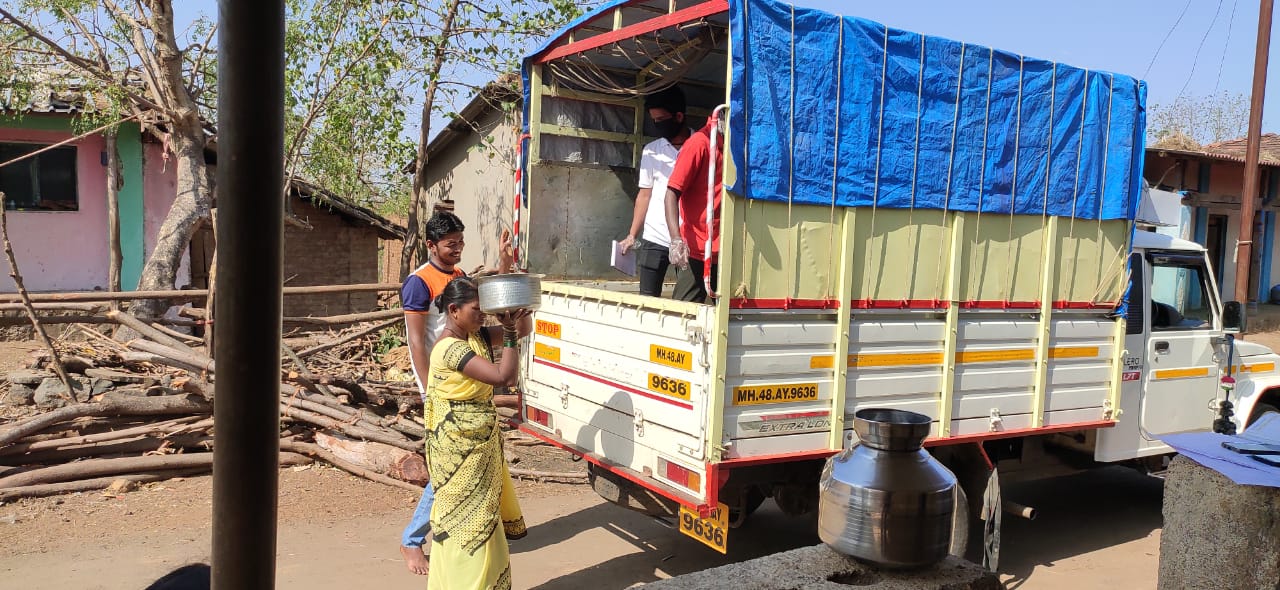
In response to the coronavirus pandemic in the country, in mid-March, the Central government ordered a shutdown of all educational institutes, including anganwadis in the country.
“Till March 17, anganwadis were functional, and children, and pregnant and lactating mothers were coming for their regular meals,” said Hiwale. Thereafter, kids and mothers were informed not to visit the anganwadis because of the pandemic. On March 24, anganwadis were completely shut down and will remain so till further directions, she informed.
Shutting down anganwadis has been a concern, as it stretches the nutrition needs of 158 million under-six kids, and the pregnant and lactating mothers in the country.
According to the Union health ministry’s Comprehensive National Nutrition Survey 2016-2018, 35 per cent, 33 per cent and 17 per cent of children under-five in the country are stunted, underweight and wasted, respectively. About 11 per cent of children aged six to 59 months are acutely malnourished.
On March 18, taking suo moto cognisance of suspension of mid-day meals and meals for children under-six in anganwadis across the country, the Supreme Court of India issued notices to all the state governments and union territories to explain how these meals would reach the beneficiaries amid pandemic.
State governments and district administrations have now started distributing dry ration to the beneficiaries.

Take the case of Buldhana district in Vidarbha region of Maharashtra. The district has 2,571 anganwadis and 141 mini-anganwadis (mini-anganwadi is meant for villages with less than 300 population).
These anganwadis meet the nutritional needs of 75,766 kids in the age group of six months to three years, 79,553 kids in three years to six years category, and 28,424 pregnant and lactating women in the district, Sanmugarajan Selvam, chief executive officer of Zilla Parishad Buldhana informed Gaon Connection.
Because of the coronavirus pandemic, the district administration is providing two months dry ration — March and April months — to all the anganwadi beneficiaries. It includes wheat, rice, red chilli, turmeric, soya bean oil, red lentils, and yellow split peas.
According to Selvam, all the registered pregnant and lactating women, and kids in the age group of six months to three years in the district have been provided two months take-home ration. Distribution of ration to 3-6 years kids is at present underway.
“We are trying our best to ensure that no kid, or pregnant and lactating mother’s concerns go unaddressed in this time of crisis,” Suman Rawat Chandra, collector of Buldhana told Gaon Connection. “Take-home ration is being distributed following all social distancing protocols. Women leaders are at the forefront of this expeditious exercise,” she added.
Hiwale explained how dry ration is being distributed: “We either call one adult member from the beneficiary’s family to the anganwadi centre to collect dry ration, or home deliver it in case someone from the family cannot come to collect the ration.”
At anganwadis, we are following physical distancing and have marked points with chalk for people to wait their turn. When they come to collect ration, we also inform them about handwashing and keeping safe during coronavirus outbreak, she added.
One of the challenges being faced by the local administration is the lack of human power to carry out doorstep delivery of ration. “The human power required in distributing the dry ration in big villages is being addressed with the help of gram panchayat staff that helps arrange vehicles to carry ration home to home,” informed Selvam.
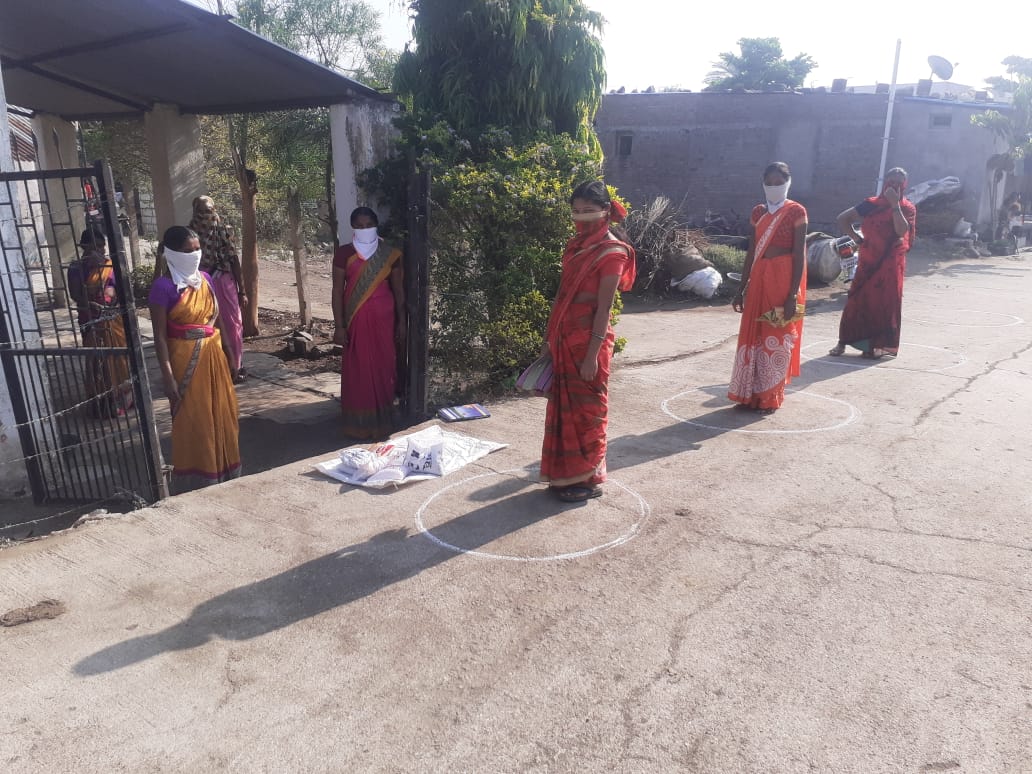
In keeping with the apex court’s directions, almost all the states and union territories have started supplying dry ration to the beneficiaries of the supplementary nutrition programme.
Maharashtra has nearly a lakh anganwadi and mini-anganwadi centres that are delivering take-home ration of chana (gram), masoor dal (red lentil), rice/wheat, turmeric powder, red chilli powder, salt and soyabean oil.
On the eastern side, as per the Government of Odisha’s Master Circular on Lockdown dated March 29, 2020, all anganwadi centres in the state are shut till April 30. One month’s take-home ration or hot cooked meal is to be provided at doorsteps of beneficiaries covered under the supplementary nutrition programme of the ICDS, reads the circular.
For kids aged six months to three years, chhatua, dry ration, ladoos/chikkis, etc is to be provided. For pre-school children (3-6 years), dry ration of rice, pulses, oil, condiments, salt, etc is to be delivered. Apart from this, eggs, as per entitlement, are to be “distributed on a weekly basis at the household level. In case of issues in the availability of eggs, substitutes, such as soya nodules, are to be provided without compromising with the nutrition norms.”
The Odisha government circular Cleary mentions home delivery of ration is to carried out by anganwadi workers and helpers by following “all standards of hygiene (use of masks, gloves, sanitisers and proper washing of hands with soap) and protocols of social distancing (maintaining more than one-meter distance with co-workers, beneficiary, etc and not to congregate more than seven persons at one point of time).”
Telangana is home delivering dry ration to beneficiary kids and women on a weekly basis. Every pregnant and lactating mother is being given 900 grams (gm) rice, 180 gm dal, oil and three eggs per week. Beneficiary children are being provided 450 gm rice, 90 gram dal and three eggs per week.
Meanwhile, in Chhattisgarh, members of the Right To Food Campaign Chhattisgarh complain proper dry ration is not being supplied to the anganwadi kids. “Rather than providing anganwadi kids, and pregnant and lactating mothers dry ration, including rice, pulses, oil, etc, the state government is only distributing packets of take-home ration premixes,” Gangabhai Paikra associated with Right to Food Campaign Chhattisgarh told Gaon Connection. “However, school children enrolled under the mid-day meal scheme in the state are being provided dry ration of rice and pulses,” he added.
Some news reports point out how anganwadi workers in Uttarakhand have refused to home deliver dry ration to beneficiaries citing fear of coronavirus. They want the ration picked up from the anganwadi centres.
The fear is understandable. For instance, Malur, an anganwadi worker from Kolar, Karnataka complained she neither has a proper face mask, nor transport facility to deliver the take-home ration.
Parents and brother of Hiwale, an anganwadi worker in Buldhana, Maharashtra are worried, too.
“I assure my parents I wear the mask full day and keep washing my hands regularly. As soon as I reach home in the evening, I straight head to take a bath and wash my clothes before meeting my family. No doubt, these are difficult times,” said Hiwale.
And, to imagine, these frontline women health workers, who are helping fight a pandemic, do not even receive minimum wages and have been fighting for the same for the last few years. But without much success.

